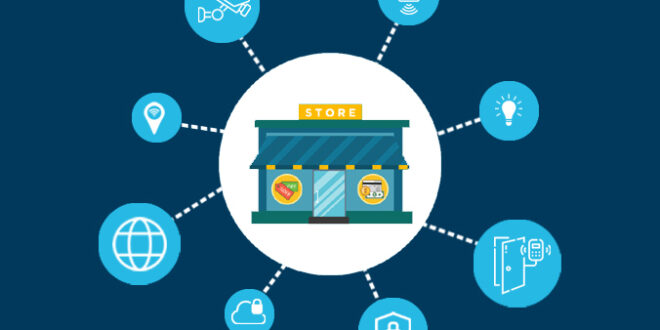IoT technology is shaking up the retail industry, influencing everything from how customers interact with brands to how businesses operate.
Below are just some of the ways that IoT is currently changing the retail sector for the better. Learn about how data collection is becoming more efficient, why warehousing concerns are disappearing, and more.
Using IoT for Data Collection

Many businesses are still in the dark about big data, but retail is catching on. By using smart applications, retailers can quickly deliver what customers want and close the gap between customer expectations and vast amounts of data.
For example, you can use the Internet of Things to monitor foot traffic and shopper patterns. Though it may seem like a no-brainer way to improve brand engagement, it comes with many benefits. Here are three ways that IoT can help the retail sector:
- By incorporating data into their techniques, retailers can upgrade from older methods of store design and inventory arrangement.
- Stores have the opportunity to merchandise products by placing them where customers can easily find them.
- By strategically placing promotional deals in areas with a high volume of foot traffic, brands can create more awareness for their products with less effort.
Improved Customer Experiences
We often don’t think about how the act of shopping has stayed relatively similar for hundreds of years, but IoT is slowly changing that in retail settings.
Checkout options like self-checkout and no-checkout can help shoppers transition more quickly and conveniently. These seamless shopping experiences offer more control to shoppers and can make the overall process much smoother.
In today’s age, customers can also elect to pay through mobile apps as opposed to carrying a physical wallet or bank cards. This offers greater security for the customer and retailer alike. Moreover, apps provide retailers with increased data regarding consumer spending patterns and product preferences that they can use to streamline the shopping experience. For example, if a customer’s favourite product is unavailable, retailers can send notifications offering alternative products. Additionally, smart notifications that tell shoppers when purchased items have expired are now possible thanks to this technology shift.
Warehouse Efficiency

Throughout larger warehouses, it can be very challenging to find where stock is located. If workers cannot locate the items, sales drop and customer satisfaction plummet.
By implementing IoT into retail, warehousing and other operations will become much more efficient. Search times will be cut down significantly, while applications offer data that would otherwise not be easy to come by. This includes being able to predict things like shelf space needs, customer demand rates, and how quickly stock might deplete. In short: revenues will increase while meeting the demands of customers becomes easier than ever before.
Management of Supply Chains
The struggles of supply chain management are well-known; inflated costs, more complicated routes to market due to numerous channels, and shifting consumer needs for quicker delivery and improved quality. It’s not an easy industry to succeed in.
IoT can quickly and easily simplify supply chain operations. For example, retailers using an Iot Device Management solution based on open standards. They’re highly scalable platforms for device lifecycle management that allows for rapid deployment, testing, and issue resolution so that retailers can track the entire supply chain.
With data transparency, retailers have more control than ever before. They can monitor production progress, track shipments from suppliers, and use storage optimally to keep goods fresher for longer – all the way until customers take them home.
Maintenance of Predictive Equipment

If any part of your equipment fails, it can disrupt your entire operation. For retailers, this can mean substantial losses in inventory and revenue from missed shipments, stocking issues, and storage problems. By using predictive equipment maintenance though, you can stay on top of necessary repairs and avoid these disruptions.
By monitoring equipment, any events that could potentially damage the equipment can be discovered and avoided. For example, by using sensors, retailers can immediately detect changes in equipment behaviour such as unusual vibrations or movement, temperature changes, etc.
IoT in retail is the next step toward more efficient operations. By connecting devices and using smart software, retailers can improve their competitive advantage, get closer to their customers, offer better shopping experiences, and streamline service delivery.
As you can see, there are many ways in which IoT can be used to improve the retail experience for both customers and retailers alike. With such a wide range of benefits, it’s no wonder that more and more retailers are embracing technology. In the coming years, we can expect to see a continued rise in IoT adoption in the retail industry.
Future of IoT in Retail
The internet of things has revolutionized how businesses can track, store and manage data. In the retail industry, IoT is used to give customers a more enjoyable shopping experience and allow retailers to gain real-time insights into their operations. By connecting physical objects to the network, such as in-store sensors and RFID tags, retailers can gather data from across their entire organization in real time. This gives them the ability to personalize their customer service offerings, optimize supply chain processes and increase efficiency in operations.
Connected technologies have changed the way retailers do business with personalized services that engage shoppers and drive impulse purchases. IoT devices and applications enable retailers to track every step of a customer’s journey through physical stores or online portals – right up to delivering newly purchased items directly to customers’ doors. Furthermore, these technologies are allowing stores to monitor stock levels differently while predicting when certain areas may be running low on inventory, so that they can quickly restock before sales are lost.
The common thread that ties these technology advancements together is data — much of which comes from sensors connected with the Internet of Things. By collecting data from innovative new devices placed throughout physical stores or within products themselves, retailers are able to gain insight into customer behaviors within stores as well as how products interact with each other for better recommendations. All this extra information allows them to make timely decisions at a much faster pace than humanly possible without any disruptive guesswork involved.
 Imagup General Magazine 2024
Imagup General Magazine 2024



